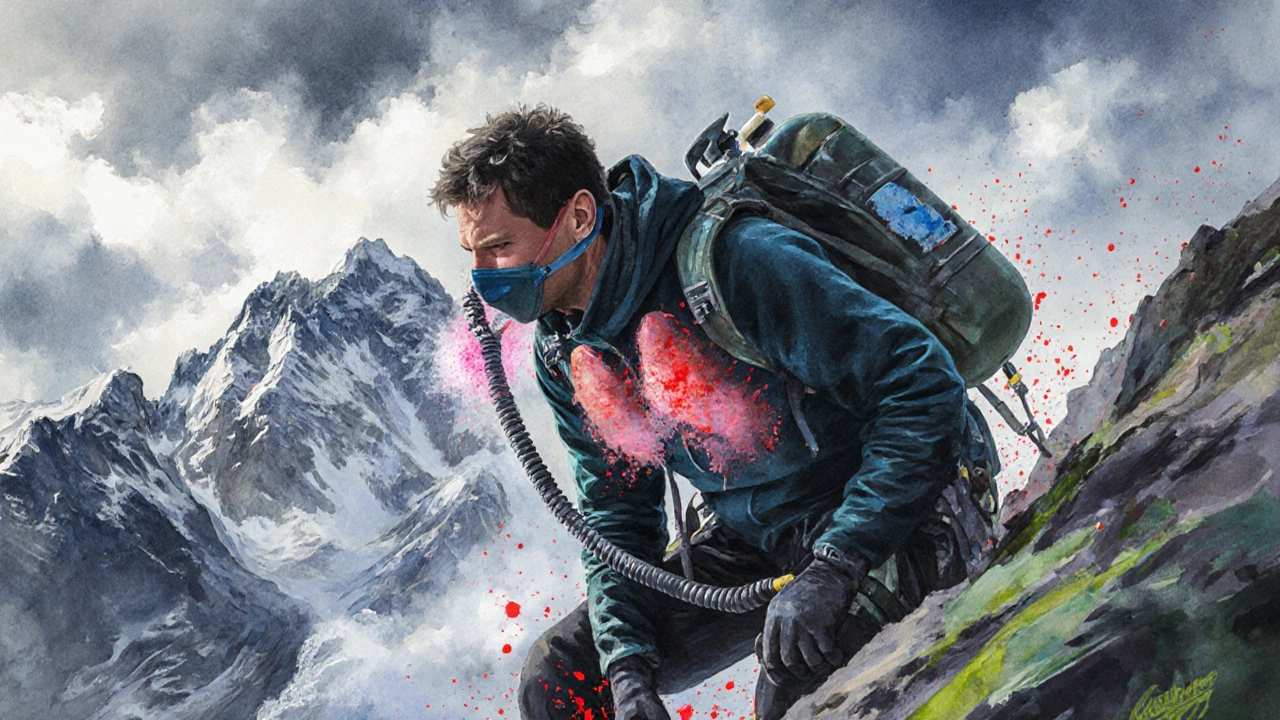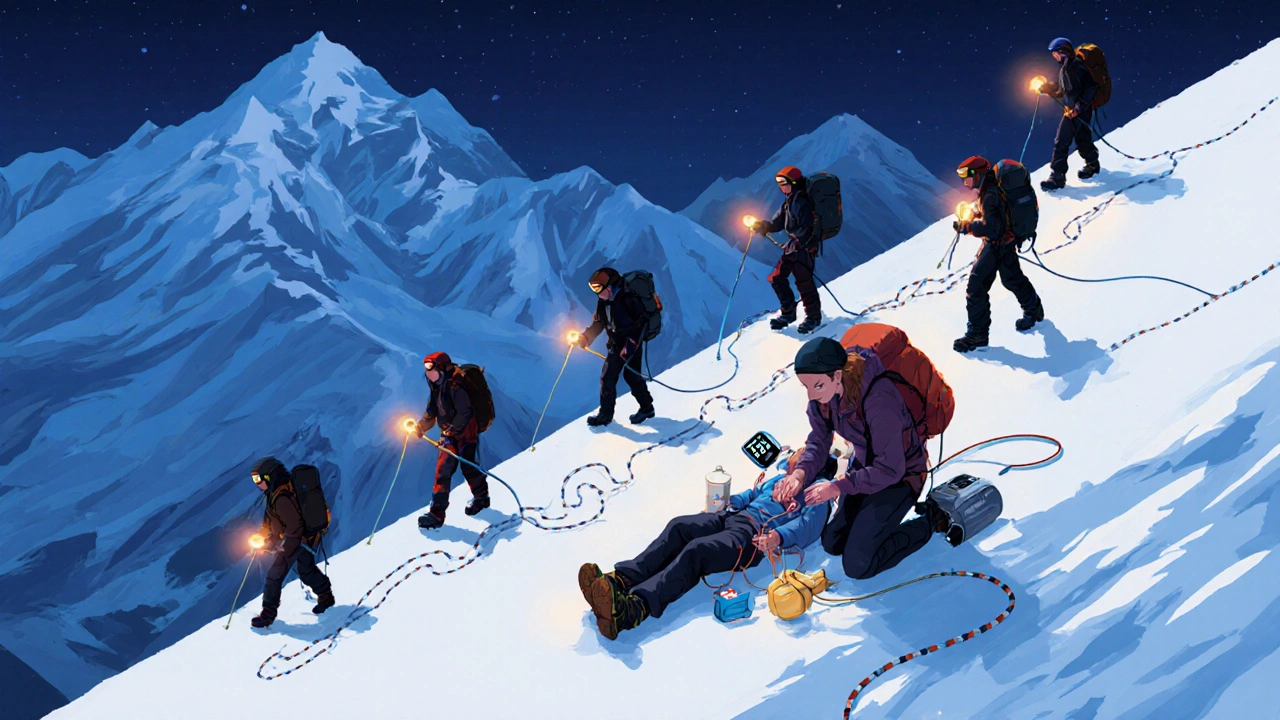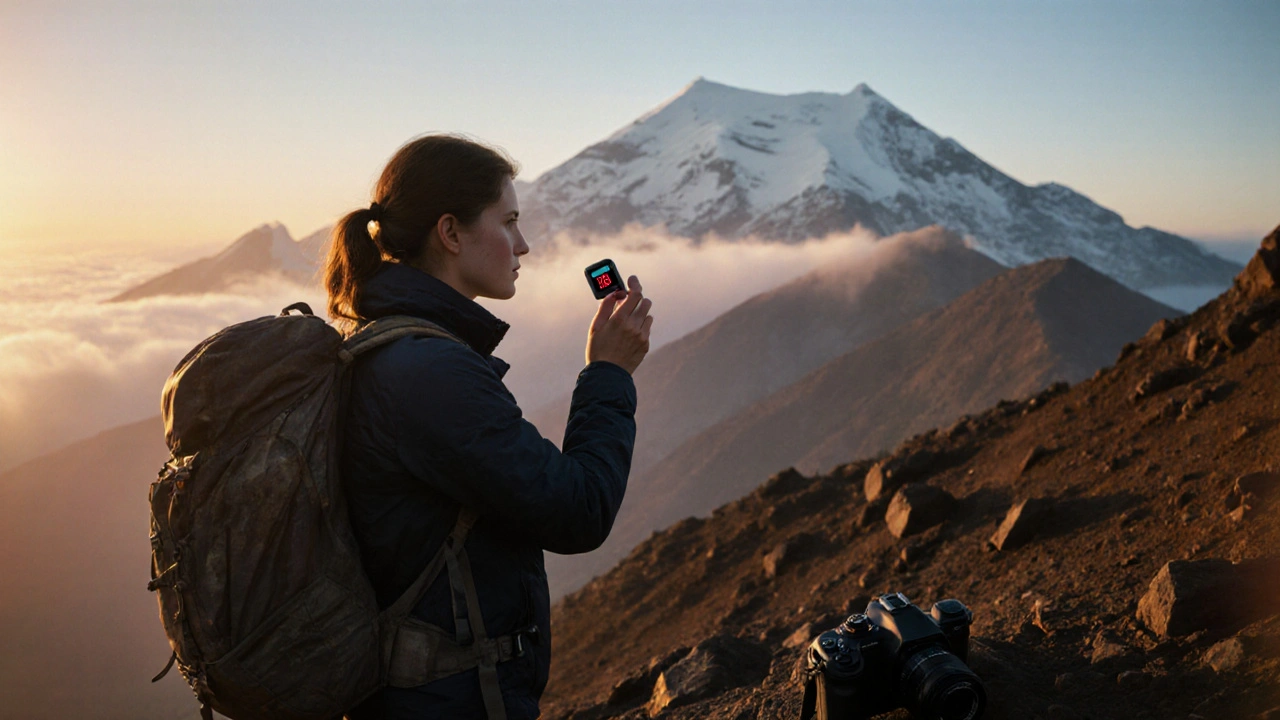Altitude Illness Symptom Checker
Check for Altitude Illness Symptoms
Answer the following questions to assess your condition. Each symptom checked increases the risk level.
Your Risk Assessment
Key Takeaways
- Three main forms of altitude illness-AMS, HAPE, and HACE-have distinct symptoms and treatment needs.
- Early self‑assessment with a Pulse Oximeter a portable device that measures blood oxygen saturation, can catch trouble before it escalates.
- Medications such as Acetazolamide a carbonic anhydrase inhibitor that speeds acclimatization and Dexamethasone a steroid used for severe cerebral swelling save lives when used correctly.
- Every case study underscores one rule: never ignore worsening headache, breathlessness, or confusion.
- Preparation-graded ascent, hydration, and a knowledgeable Sherpa Guide an experienced high‑altitude assistant familiar with local weather and terrain-greatly reduces risk.
Understanding Mountain Sickness the collective term for health problems caused by rapid ascent to high elevations
When you climb above 2,500 meters (8,200 feet), the air contains less oxygen. Your body reacts by breathing faster, heart rate increasing, and producing more red blood cells. If the ascent is too quick, the physiological response can’t keep up, leading to what hikers and doctors call mountain sickness. The condition isn’t a single disease; it’s a spectrum ranging from mild headache to life‑threatening brain swelling.
The Three Principal Forms of Altitude Illness
Medical research groups the illnesses into three categories. Knowing which one you’re facing is the first step toward effective treatment.
Acute Mountain Sickness (Acute Mountain Sickness the mildest form, usually appearing 6-24 hours after ascent)
Typical signs are headache, nausea, loss of appetite, and light‑headedness. Most people recover with rest and hydration, but if symptoms worsen after 24hours, it could be a prelude to the more serious forms.
High Altitude Pulmonary Edema (High Altitude Pulmonary Edema fluid accumulation in the lungs that impairs oxygen exchange)
HAPE strikes 2-5 days after rapid ascent. Breathlessness at rest, cough producing frothy sputum, and a rapid pulse signal a medical emergency. Descent is the only definitive cure; supplemental oxygen and nifedipine can buy time.
High Altitude Cerebral Edema (High Altitude Cerebral Edema brain swelling that leads to confusion, ataxia, and loss of consciousness)
HACE usually follows untreated AMS or HAPE. A worsening headache, inability to walk straight, or sudden drowsiness means the brain is swelling. Immediate descent, oxygen, and high‑dose Dexamethasone a corticosteroid that reduces cerebral inflammation are critical.

Quick Comparison of the Three Illnesses
| Condition | Typical Onset | Key Symptoms | First‑Line Treatment |
|---|---|---|---|
| Acute Mountain Sickness | 6-24h | Headache, nausea, fatigue | Rest, hydration, Acetazolamide 125mg BID |
| High Altitude Pulmonary Edema | 2-5days | Dyspnea at rest, cough with pink sputum, rapid pulse | Immediate descent, oxygen, nifedipine 20mg QD, consider CPAP |
| High Altitude Cerebral Edema | 24-48h (if AMS unchecked) | Severe headache, ataxia, altered mental status | Immediate descent, oxygen, Dexamethasone 4mg IV/PO q6h |
Real‑World Case Studies: Survival Stories from the Roof of the World
Numbers and charts are useful, but nothing teaches like a lived experience. Below are three concise narratives that illustrate the spectrum of altitude illness.
Case 1 - The Fast‑Paced Trekker (AMS)
Emma, a 32‑year‑old photographer, attempted a rapid ascent of Kilimanjaro’s Uhuru Peak in four days. On day two, at 3,800m, she complained of a throbbing headache and loss of appetite. She ignored the signs, thinking “it’s just a cough.” By night three, she was vomiting and unable to walk. A fellow climber used a Pulse Oximeter a handheld device that displayed an oxygen saturation of 78%. They descended to 2,800m, administered 250mg Acetazolamide, and Emma recovered in 24hours. The key lesson: even mild headache at 3,000m warrants a pause and oxygen check.
Case 2 - The Solo Alpinist (HAPE)
Raj, a 45‑year‑old climber, attempted an unaided summit of Annapurna in September 2023. After a 1,200m gain in eight hours, he started gasping for air at 4,500m. He noted pink‑tinged frothy sputum-a hallmark of fluid in the lungs. Raj lacked a guide but carried a portable oxygen canister and a lightweight CPAP mask. He descended 1,500m under his own power while using the oxygen; his SpO₂ rose from 70% to 88%. En route he was rescued by a local Sherpa who administered nifedipine. Raj survived but spent two weeks in a hospital for pulmonary monitoring. This story shows that self‑contained emergency gear plus a rapid descent can be the difference between life and death.
Case 3 - The Expedition Leader (HACE)
Lena, a 38‑year‑old guide leading a ten‑person group on Denali, noticed one client’s confusion and inability to coordinate steps at 5,200m. The client’s vitals showed a heart rate of 115bpm and SpO₂ of 73%. Lena administered 4mg Dexamethasone IV and set up a portable oxygen supply. Simultaneously, the entire group began a controlled descent. Within 45minutes, the client’s cognition cleared, and his SpO₂ climbed to 92%. The prompt use of Dexamethasone, combined with oxygen and descent, halted a potentially fatal cerebral edema. The takeaway: carry steroids as part of any high‑altitude medical kit.
Early Warning Signs & Self‑Assessment Checklist
Before panic sets in, ask yourself these questions every morning and evening at altitude:
- Do I have a persistent headache that doesn’t improve with ibuprofen?
- Is my appetite reduced or am I feeling nauseated?
- Am I short of breath while walking on flat ground?
- Do I notice a cough, especially with frothy sputum?
- Is my thinking foggy, or am I stumbling when I walk?
- What does my Pulse Oximeter read? Below 85% is a red flag.
If you answer yes to any of the first three, pause, hydrate, and consider a dose of Acetazolamide. If symptoms involve the lungs or brain, start descent immediately and use oxygen.

Emergency Treatment Protocols for the Unexpected
Most climbers carry a small medical kit. Here’s a concise, field‑ready protocol that fits into a 1‑liter backpack.
- Medications: Acetazolamide 125mg (twice daily), Dexamethasone 4mg (IV/PO), Nifedipine 20mg (oral, for HAPE).
- Equipment: Pulse Oximeter, portable oxygen cylinder (2L), CPAP mask, emergency thermal blanket.
- Steps:
- Assess symptoms and SpO₂.
- If SpO₂<85% or severe symptoms, administer supplemental oxygen (2L/min).
- Give Acetazolamide for AMS, Dexamethasone for HACE, Nifedipine for HAPE.
- Begin immediate descent-aim for at least 500m drop every hour.
- Re‑evaluate every 30minutes; if no improvement, call for rescue.
Remember, medications help but do not replace descent. Oxygen buys time; the mountain will still win if you stay too high.
Preparing for Your Next Summit: Prevention Over Cure
Every tragedy starts with a preventable mistake. Incorporate these habits into your training plan:
- Gradual Acclimatization: Gain no more than 300-500m of sleeping altitude per day after 2,500m, and take a full rest day every 3-4 days.
- Hydration Strategy: Drink at least 3L of water daily; add electrolytes to avoid hyponatters.
- Pre‑Trip Medication: Start Acetazolamide 24h before ascent (125mg BID) if you’ve had prior AMS.
- Gear Checklist: Pack a lightweight Pulse Oximeter, a 2‑L oxygen cylinder, and a small dose of Dexamethasone.
- Team Communication: Assign one person as the “symptom monitor” who checks vitals each morning.
Following these steps converts a risky climb into a manageable adventure.
Frequently Asked Questions
Can I prevent mountain sickness completely?
No method guarantees 100% prevention, but gradual ascent, proper hydration, and prophylactic Acetazolamide reduce risk dramatically.
Is a headache always a sign of AMS?
A headache is the most common early symptom of AMS, yet it can also result from dehydration, fatigue, or tension. Check for other signs like nausea or shortness of breath to confirm.
How fast should I descend if I suspect HAPE?
Begin descending immediately, aiming for at least 1,000m drop within the first hour. Combine descent with oxygen and, if available, nifedipine.
Do I need a prescription for Dexamethasone on a climb?
Yes, Dexamethasone is a prescription steroid. Obtain it from a physician before the expedition and carry clear dosing instructions.
Can low‑tech tools like a simple altitude chart replace a pulse oximeter?
Altitude charts help estimate risk, but they cannot measure oxygen saturation. A cheap pulse oximeter adds an objective data point that can catch silent hypoxia early.
Altitude brings awe, but it also demands respect. By studying real cases, mastering early detection, and packing the right gear, you turn "danger" into "challenge." Stay safe, stay curious, and keep climbing.


Raghav Suri
October 9, 2025 AT 16:20Don't think you can ignore a headache at 3,800m and keep trudging. The data in those case studies are crystal clear: descent saves lives, period. If you’re not willing to listen to your own body, you’re just courting disaster.
Freddy Torres
October 10, 2025 AT 20:07Mountains whisper warnings in thin air; a throbbing head is their shout. Take a breath, check your oximeter, and respect the altitude.
Andrew McKinnon
October 11, 2025 AT 23:53Oh sure, because every seasoned alpinist loves a good headache as a souvenir, right? In reality, those “souvenirs” are just early signs that your brain is pleading for oxygen. Let’s swap the sarcasm for a descent and some meds.
Dean Gill
October 13, 2025 AT 03:40The three case studies you laid out paint a vivid picture of how quickly things can slip from mild AMS to life‑threatening HACE.
The first, Emma’s experience underscores the textbook rule that a persistent headache at 3,800 m is not just a nuisance but a red flag.
Her initial denial delayed treatment, but the quick use of a pulse oximeter revealed a saturation of 78 %, which forced the team to descend.
That descent, combined with a dose of acetazolamide, turned what could have been a fatal situation into a full recovery within a day.
Raj’s solo push on Annapurna illustrates the perils of pushing speed over safety, especially when the ascent rate exceeds 150 m per hour.
The appearance of frothy pink sputum is the hallmark of HAPE and should trigger immediate oxygen therapy and descent.
His ability to self‑administer a portable CPAP while climbing was impressive, yet it was the Sherpa’s timely nifedipine that truly bought him time.
Lena’s leadership on Denali shows why guides must carry dexamethasone and be ready to use it at the first sign of cerebral edema.
The client’s SpO₂ of 73 % and altered mental status were textbook HACE, and the 4 mg IV dose of dexamethasone likely prevented irreversible brain injury.
Across all three narratives, the common thread is the rapid decision to descend; no medication can replace the physics of lower altitude.
Hydration, gradual ascent, and pre‑acclimatization are the low‑cost, high‑impact strategies that should be built into any trek plan.
Pulse oximeters are invaluable, but they are only as good as the user’s willingness to act on the numbers.
The “stop‑or‑go” rule-if you feel worse after a night at a given camp, you either rest longer or go down-remains the simplest yet most effective safety net.
In practice, a good rule of thumb is to never ignore a headache, breathlessness, or confusion that persists beyond a few hours.
Finally, always pack a lightweight medical kit that includes acetazolamide, dexamethasone, nifedipine, a small oxygen cylinder, and a reliable oximeter.
When you combine proper preparation with a willingness to listen to your body, the mountains become a challenge you can meet, not a fatal trap.
Royberto Spencer
October 14, 2025 AT 07:27Your stories are fine, but remember that hubris is the real enemy on any summit; pride will always precede a fall.
Annette van Dijk-Leek
October 15, 2025 AT 11:13Stay safe, stay hydrated, stay aware!!!
Katherine M
October 16, 2025 AT 15:00The elucidation of altitude‑related pathophysiology presented herein is commendable; it integrates both empirical data and pragmatic guidance. 🌄
Bernard Leach
October 17, 2025 AT 18:47I appreciate the scholarly tone of the previous comment and would add that the inclusion of culturally specific acclimatization practices-such as the Sherpa's tea ceremonies and paced ascent rituals-can augment physiological adaptation, thereby reducing the incidence of AMS, HAPE, and HACE among diverse climbing cohorts.
Shelby Larson
October 18, 2025 AT 22:33Honestly, the only thing more dangerous than HAPE is the wilful ignorance you see in some trekkers; they definately think they can push through, but the results are always wierd and tragic, and that's just common sense.
Mark Eaton
October 20, 2025 AT 02:20You've nailed the mindset problem, and the solution is simple: educate before you ascend. A quick pre‑trip briefing on symptom checklists can save lives. Remember, knowledge is the best gear you can carry.
Alfred Benton
October 21, 2025 AT 06:07One must consider that the promotion of commercial altitude‑medicine kits is not merely a profit motive but part of a larger orchestrated agenda to condition mountaineers into dependency. The selective dissemination of research by elite institutions serves to obscure indigenous low‑tech remedies that have sustained Himalayan peoples for centuries. While the data you present is valuable, it is prudent to remain skeptical of narratives that marginalize traditional knowledge. Question everything, especially the source of the “standard” protocols.